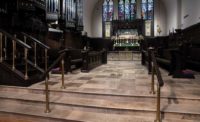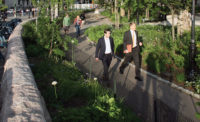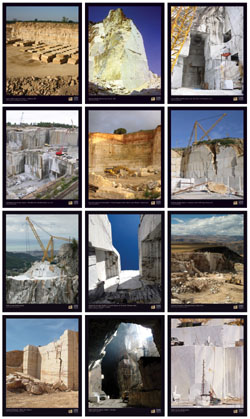The University of Mary is a private, Christian, Catholic and Benedictine university near Bismarck, ND, which was established 60 years ago. Originally known as Mary College, the University is the largest degree-granting institution in Bismarck.
For its new outdoor grotto, known as Marian Grotto, architects drew inspiration from the renowned Grotto of Massabielle in Lourdes, France. “Over the centuries, the swift-flowing Gave de Pau river has eroded a cavern into the side of the mountain. And it was in this grotto in 1858 that the young girl, Bernadette Soubirous, had numerous visions of Mary, the mother of Jesus,” explained architect, Adam Hermanson, owner of Integration Design Group in Arvada, CO. “The site of the apparitions is a major pilgrimage destination and has witnessed a countless number of miraculous healings. The miracles are connected with the water that flows from a spring inside the grotto. Natural stone, arranged in a flowing composition, was central to the design concept of this new grotto.”
Traditionally, grottos are composed of limestone. However, in keeping with the design on campus, Glacial Till Splitface from RealStone in Bagley, MN was specified, which is seen on several buildings. The material was supplied by Coldspring of Cold Spring, MN.
“Glacial Till granite is the technical name for one of our core raw materials,” said Mike McManimon, president of RealStone. “These natural, rounded boulders were transported and deposited across the landscape by glaciers across the upper Midwest as they began melting thousands of years ago. All of RealStone’s Glacial Till granite material is responsibly harvested out of the ground from Polk and Clearwater Counties in northern Minnesota.”
In total, 12,630 square feet of flats and 1,946 linear feet of corners of the local granite was used to create the grotto. “The project called for a blend of three different sizes, ranging from 6 to 24 inches in diameter,” said McManimon. “This was a challenging process, as the larger diameters of stone are more difficult to work with and produce within spec. However, it was worth the effort, as this blend ended up being the perfect fit for the design elements and inspiration to create the beautiful buildings at the University of Mary.”
“The natural stone is part of the architectural language woven throughout the University’s buildings,” added Hermanson.
Marian Grotto is located at the center of the campus, positioned on a bluff overlooking the Missouri River Valley to the west. It serves as a quiet place of pilgrimage, prayer and recollection. “The curving path that descends down toward the grotto is accented by a low stone and concrete wall as it carves down into the landscape,” said Hermanson. “The stone is used to mark the places of rest, where benches are oriented for seating toward the westward view.
“The design of the path and the grotto employ an organic curving geometry, and this presented some challenges for the masons as the vision became a reality,” the architect went on to say of the 1,300-square-foot grotto and 1,800-square-foot pathway. “We worked with the masons to carefully select particular stones for the curves, wall caps and archways to achieve a unified overall appearance.”
Approaching the grotto area from the path, the stone walls rise up in curves, holding back the landscape without completely encasing it, providing a more sheltered space from the wind and winter snows. “Landscaped steps are created inside the space of the grotto and the great stone arch extends up and over the rows of votive candles,” said Hermanson. “The candles offer an opportunity for memorials and prayers for loved ones and special intentions, and the glow from the candlelight plays off the rough surfaces of the stones on the vaulted dome above.”
The centerpiece of the grotto is the statue of Mary, which was commissioned by the University, especially for this new grotto. “She extends her hands outward and is surrounded by a shadowy recess in the stone surface, very similar to the way that she appeared to the young girl Bernadette at Massabielle,” said Hermanson. “To the right of the statue, a small stone has been set into the wall — a piece of Massabielle, gifted to the University by friends in Lourdes, France. This stone provides a physical connection between the many miracles and answered prayers of the pilgrims in Lourdes, and the prayers and intentions requested in this new sacred space in Bismarck.”
With a complex curvature and unique geometry, the construction of the grotto presented a couple of minor challenges, but overall was completed successfully in just nine months. Hermanson and his team were on-site regularly during the stone installation, working closely with the masons to help ensure the right mix of stone size, color and shape. “We needed to coordinate the 2-D corners and verify adequate attachment for some of the larger stones,” he said. “We also needed to review the details of grouting for the proper weathering, durability and appearance.”
Since Marian Grotto’s completion, the University and benefactors have been overjoyed. “Students, staff and visitors are coming to the grotto and praying there every day,” said Hermanson. “I think it has really fulfilled the expectations of the owner in the ways that it is being used.”
|
Marian Grotto at University of Mary Bismarck, NDArchitect: Integration Design Group, Arvada, CO Stone Quarrier: RealStone, Bagley, MN Stone Supplier: Coldspring, Cold Spring, MN (RealStone’s Glacial Till Splitface granite) |













